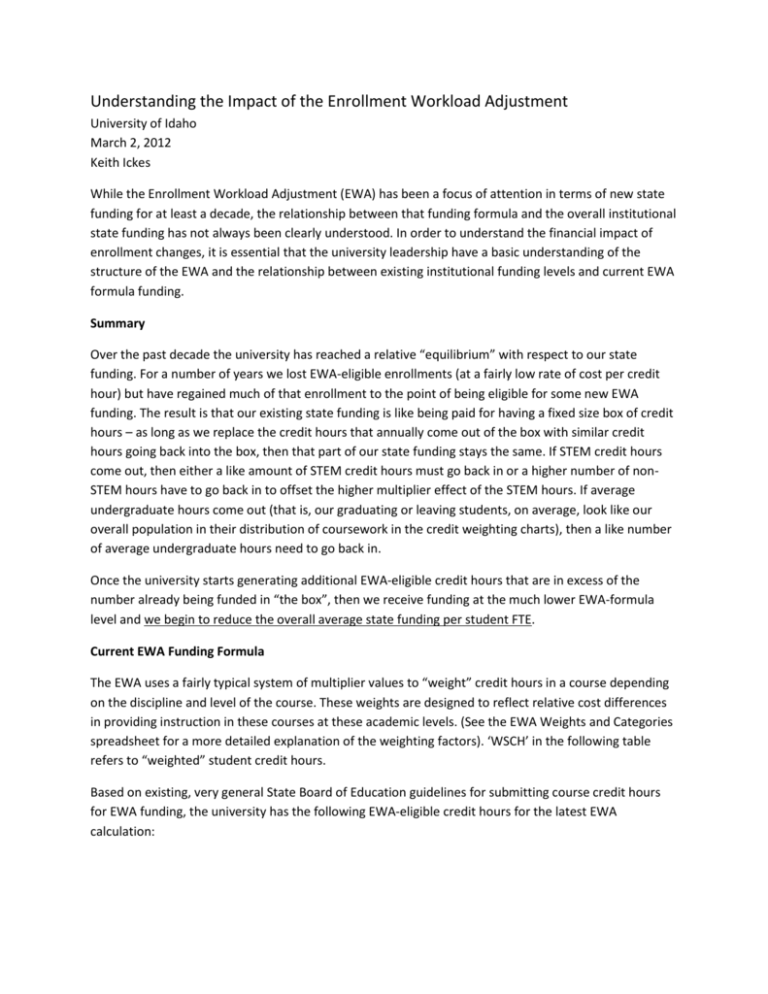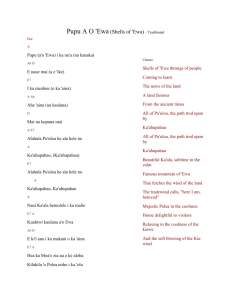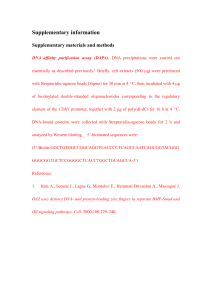Understanding the Impact of the Enrollment Workload Adjustment
advertisement

Understanding the Impact of the Enrollment Workload Adjustment University of Idaho March 2, 2012 Keith Ickes While the Enrollment Workload Adjustment (EWA) has been a focus of attention in terms of new state funding for at least a decade, the relationship between that funding formula and the overall institutional state funding has not always been clearly understood. In order to understand the financial impact of enrollment changes, it is essential that the university leadership have a basic understanding of the structure of the EWA and the relationship between existing institutional funding levels and current EWA formula funding. Summary Over the past decade the university has reached a relative “equilibrium” with respect to our state funding. For a number of years we lost EWA-eligible enrollments (at a fairly low rate of cost per credit hour) but have regained much of that enrollment to the point of being eligible for some new EWA funding. The result is that our existing state funding is like being paid for having a fixed size box of credit hours – as long as we replace the credit hours that annually come out of the box with similar credit hours going back into the box, then that part of our state funding stays the same. If STEM credit hours come out, then either a like amount of STEM credit hours must go back in or a higher number of nonSTEM hours have to go back in to offset the higher multiplier effect of the STEM hours. If average undergraduate hours come out (that is, our graduating or leaving students, on average, look like our overall population in their distribution of coursework in the credit weighting charts), then a like number of average undergraduate hours need to go back in. Once the university starts generating additional EWA-eligible credit hours that are in excess of the number already being funded in “the box”, then we receive funding at the much lower EWA-formula level and we begin to reduce the overall average state funding per student FTE. Current EWA Funding Formula The EWA uses a fairly typical system of multiplier values to “weight” credit hours in a course depending on the discipline and level of the course. These weights are designed to reflect relative cost differences in providing instruction in these courses at these academic levels. (See the EWA Weights and Categories spreadsheet for a more detailed explanation of the weighting factors). ‘WSCH’ in the following table refers to “weighted” student credit hours. Based on existing, very general State Board of Education guidelines for submitting course credit hours for EWA funding, the university has the following EWA-eligible credit hours for the latest EWA calculation: Remedial Lower Division Upper Division Masters Doctoral 1st Prof EWA SCH 327 130,515 104,176 27,135 7,648 8,186 277,987 EWA WSCH Ratio 327 178,269 219,167 127,130 58,611 30,084 613,588 1 1.37 2.10 4.69 7.66 3.68 2.21 The “ratio” that is calculated in the right-most column is the average multiplier effect of all of the courses at that level of instruction. Since lower division humanities courses have a multiplier of 1, and serve as the base for the entire system of course weights, an overall ratio greater than 1 indicates the extent to which students at the lower division level are taking courses in STEM or other higher multiplier disciplines. The EWA formula funds year-to-year changes in the number of weighted credit hours – currently the funding rate is $63.20 per weighted student credit hour for any additional credit hours. Growth in EWA credit hours is calculated on the basis of a three year rolling average. Assuming the state funded enrollment growth under the current EWA arrangement, the University of Idaho would receive, on average, the following levels of funding for new enrollment growth: For an “average” new Freshmen: $2,251 (@ 26 SCH) For an “average” undergraduate transfer at the Junior level: $3,457 (@ 26 SCH) For an “average” new graduate student: $5,330 (@ 18 SCH) This assumes that our enrollment growth approximates the existing distribution of students between high and low cost – or high and low weighted – credit hours. Current State Funding There are sometimes calculations made that attempt to portray the entirety of state support for an institution in terms of state dollars per student FTE. It is common to see this on a national level when groups of peer institutions want to compare relative funding levels or as a proxy for a relative cost model for conducting business when compared to institutions with similar roles and missions. Knowledgeable financial managers understand that such simplifications eliminate the classic, and appropriate, business distinction between “fixed” and “variable” costs, treating all costs as if they were “variable” and a direct function of enrollment. Nevertheless, such comparisons can be useful in understanding what financial resources are required for a well-run institution, with similar role and mission, to provide a given quality of instruction and research. The current (FY12) state funding for the University of Idaho is $77,171,800. The corresponding total student FTE of funded enrollment, based on EWA-eligible course credit hours, is 9,581 FTE. This is calculated by looking at credit hours by course level and using the following determinations of FTE enrollment: - 30 SCH for one undergraduate FTE; 24 SCH for one masters level FTE; 20 SCH for one doctoral level FTE; and 35 SCH for one first professional level enrollment. A simple division (total state dollars divided by total EWA-eligible FTE) shows that the University of Idaho in FY12 is funded, on average, at the level of $8,055 per student FTE. Current Funding vs. EWA Funding There are several conclusions that can already be drawn from these two analyses – current state funding per student and EWA funding for growth: 1. If the institution sustains all of the existing EWA-eligible student credit hours with the same type of student that now creates those credit hours (graduate, undergraduate, resident, and nonresident waiver recipients), then any growth in EWA-eligible credit hours will be funded at the current EWA formula level and will result in a reduction in the overall average state funding per student FTE. This is the primary reason why all four state institutions have almost always preferred that the SBOE fund “special allocations” over EWA funding. This problem occurs because the university is currently funded (on average) at the rate of $8,055 per FTE and would only be funded $2,251 for an additional UG FTE or even $5,330 for an additional graduate FTE. In both cases, the funding per new student is well below the existing university overall average of $8,055. Example: Base State Funding EWA Funding Additional Enrollment New Total $77,171,800 $450,200 * $77,622,000 Funded FTE Additional UG Enrollment New Total FTE 9,581 200 9,781 New Funding per FTE $7,936 per student FTE *The example EWA increase is determined by taking the projected growth of 200 undergraduates times the average student load of 26 annual credit hours times the average lower division “ratio” or multiplier of 1.37 time the EWA growth funding rate of $63.20 per weighted student credit hour: 200*26*1.37*$63.20 = $450,236. 2. If the institution grows, at least in part, through “substitution”, then very different results happen. For example, if a non-resident undergraduate, who was receiving a full non-resident tuition waiver, graduates and the institution replaces the resulting lost EWA-eligible credit hours with credit hours from an additional resident undergraduate student, then our overall EWA credit hours are preserved and that new resident student effectively continues to support our average of $8,055 of state funding per student. It is as if that additional resident student was funded at the full $8,055 of existing state funding, rather than being funded as EWA growth and at the much lower level of $2,244 per student. If, in addition, we replace that original graduating non-resident (whose credit hours were “in the box” due to a waiver) with another non-resident, this time with someone who is receiving a small scholarship or perhaps even paying full non-resident tuition, then we have improved our overall per-student funding and have been able to grow our resident enrollment without being subjected to the very low levels of EWA funding for new enrollment growth. The Impact of Other State Funding Increases The material above already demonstrates the problems associated with relying solely on EWA funding as an explanation for the overall institutional funding. If you take the total state funding of $77,171,800 and divide it by the total EWA-eligible weighted credit hours of 613,588 (in the first chart above), our total state funding comes to an average of $125.77 per weighted student credit hour. As we noted above, the current EWA formula funds enrollment growth at the rate of $63.20 per weighted student credit hour – about one half of the level of our total state funding. To understand the role other state funding plays in determining the total state funding for the institution, we can use the earlier example of additional EWA funding, but add to that example several other possible funding changes: New (Hypothetical) Example: Base State Funding EWA Funding for Additional Enrollment Occupancy Costs Salary Increase at 3% $77,171,800 $450,200 $1,279,400 $2,645,100 Total New Funding $81,546,500 Current Student FTE New Student FTE Total FTE New calculated total state dollars per student FTE: 9,581 200 9,781 $8,337 Based on this example, other forms of state funding for the institution – other than EWA adjustments – resulted in an apparent increase in total state dollars per student FTE, whereas, in the example above, EWA funding alone spread over 200 additional students resulted in an overall decline in total funding per student FTE. The situation is further complicated by the fact that the legislature often does not fund the EWA increases and, in financially lean years, the legislature makes budget reductions in higher education appropriations that are unrelated to enrollment growth or decline. What is Included in EWA? - - All credit hours taken by resident students, whether graduate or undergraduate, are included in the EWA base of credit hours. This includes: o credit hours taken by faculty, staff and their spouses. o credit hours taken by senior citizens using the senior citizen discount to take classes. o credit hours taken by non-employee faculty/staff and spouses under the previous extended tuition benefit opportunity. o credit hours taken by high school students in the Dual Enrollment program. o credit hours taken in “self supporting” programs such as the EMBA or the MAT and DAT in Athletic training (this will likely change as a result of Board policy changes now being considered) All credit hours taken by a maximum of 280 non-resident undergraduates who participate in the WUE tuition program; All credit hours taken by non-resident students who have received a waiver of the nonresident fee. There are several State Board of Education (SBOE) caps on the number of such waivers: o a maximum of 225 such waivers for Athletics; o no more than 6% of total enrollment for other non-resident undergraduate waivers; o There is no SBOE cap on the number of waivers for non-resident graduate students serving as Teaching Assistants (TAs) or Research Assistants (RA s). The practice of providing state funding for non-resident students who receive tuition waivers is very different than most other states - whether or not the state uses a funding formula. History of EWA – Why we have the formula (Notes from Archie George) About 1975 the State Board of Education mandated each institution in the state conduct an annual cost study, according to National Center for Education Management Systems (NCHEMS) procedures. Each year from about 1978 through 1993 institutional costs were determined not only for instruction, but also research, public service, academic support, student services, instructional support, independent operations and scholarships. Funding levels were adjusted annually through the budget request process, based on head-to-head comparisons of costs for similar academic programs. Unique program costs, such as for agriculture, law, forestry, dentistry, etc. were not subject to adjustments as they were not taught at more than institution. In the early 1990s this cost-study approach was abandoned, largely because program cost estimates were heavily dependent on faculty self-reporting time-on-task. Institutional leadership realized that lower instructional cost estimates could be obtained by encouraging faculty to report less time in instruction and more in research, public service, etc. This trend greatly reduced the perceived integrity and credibility of the process. In addition, it became clear that allocating additional funding to an institution had no effect on the costs of the programs that “earned” them, i.e. inexpensive programs did not gradually become more expensive. The current weighted-credits approach embedded in the Enrollment Workload Adjustment removed the troublesome problem of estimating costs yearly and separately at each institution. Instead, weights were assigned to credit hours taught based on standard, nationally established estimates of instructional costs by discipline. The first “PSR 1.5-Annual Credit Hour” reports for the EWA were submitted for fiscal year 1992 and the last “Statewide Cost Study” was based on fiscal year 1993. This overlap allowed for a relatively smooth transition from one model to the other. The concept of funding adjustments based on “resident” credit hours only was introduced in 1994. It’s important to recognize that the separation of costs for instruction, research, public service, etc. is currently embedded in the EWA procedures and relies on a priori removal of appropriated funding for non-instructional activities before estimating the value of the weighted credits. In my view, a primary rationale behind initially using only 33% of the “Base Less System Needs” in the EWA worksheets was to recognize that much of what colleges and universities do is not instruction. Non-instructional funds were not intended to be either distributed or redistributed based on student credit hours. There was also some initial caution lest the EWA have unacceptably high consequences for institutional funding. Later adoption of the 67% proportion was largely to recognize that the amounts distributed based on 33% were inadequate to fully fund enrollment growth. That was during a period of universal growth across the state, so the higher proportion was expected to more closely track and reward enrollment growth at a rate closer to the actual cost of instruction.




